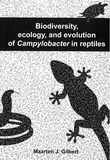Biodiversity, ecology, and evolution of Campylobacter in reptiles

Gilbert, Maarten
- Promoter:
- Prof.dr. J.A. (Jaap) Wagenaar
- Co-promoter:
- Dr. B. (Birgitta) Duim
- Research group:
- Wagenaar
- Date:
- June 30, 2015
- Time:
- 14:30 h
Summary
Species of the Epsilonproteobacteria genera Campylobacter, Arcobacter, and Helicobacter are frequently isolated from endothermic mammals and birds. However, little information was available about the presence of Epsilonproteobacteria in ectothermic reptiles and no comprehensive studies had been performed in reptiles. Due to their distinct physiology, reptiles might display a unique microbiome which can provide insights in bacterial host association, adaptation, and speciation. In this thesis, Campylobacter, Arcobacter, and Helicobacter were detected by PCR in 69.3% of the reptiles; 82.5% of the chelonians, 63.8% of the lizards, and 58.0% of the snakes were positive for one or more of these genera. Epsilonproteobacteria were cultured from 22.1% of the reptiles; most frequently from chelonians (37.0%), followed by lizards (19.6%) and snakes (3.0%). The most commonly isolated taxa were Arcobacter butzleri, Arcobacter skirrowii, and two novel reptile-associated Campylobacter taxa; Campylobacter fetus subsp. testudinum and Campylobacter iguaniorum, which are officially described in this thesis. While pathogenicity of both Campylobacter taxa in reptiles is not entirely clear, the presence in many different reptilian hosts and the lack of a clear association with disease seem to preclude a role as primary pathogen. However, Campylobacter fetus subsp. testudinum can cause infections in humans, often with a systemic component. The epidemiological information for nine human cases was summarized. All cases were in men, most of whom were of Asian origin and which were >60 years of age or had immunocompromising conditions. Infection was most likely related to exposure to Asian foods or reptiles. Campylobacter fetus comprises three recognized subspecies, which display distinct host association. Both C. fetus subspecies fetus and venerealis are associated with endothermic mammals, whereas C. fetus subsp. testudinum is primarily associated with ectothermic reptiles. To study this distinct host dichotomy, whole-genome sequencing and comparison of mammal- and reptile-associated C. fetus were performed. The genomes of C. fetus subsp. testudinum isolated from either reptiles or humans were compared to elucidate the genetic factors associated with pathogenicity in humans. Several genomic regions appeared to be subspecies specific, including a putative tricarballylate catabolism locus tcuRABC, present in C. fetus subsp. testudinum strains. Within C. fetus subsp. testudinum, sapA, sapB, and sapAB type strains were observed. The recombinant locus iamABC was exclusively associated with invasive C. fetus subsp. testudinum strains isolated from humans. A phylogenomic reconstruction was consistent with divergent evolution in niche-associated strains and the existence of a barrier to lateral gene transfer in the speciation of C. fetus. A genome comparison of C. iguaniorum strains 1485E and 2463D, isolated from a bearded dragon (Pogona vitticeps) and a green iguana (Iguana iguana), respectively, with the genomes of closely related taxa, showed that C. iguaniorum shared highest homology with C. hyointestinalis and C. fetus. In contrast to C. fetus, C. iguaniorum does not encode an S-layer and is lacking a defined LOS region. Instead, multiple predicted glycosylation regions were identified. As in reptile-associated C. fetus subsp. testudinum, a tcuRABClocus was identified. This thesis describes the first comprehensive study on Epsilonproteobacteria biodiversity, ecology, and evolution in reptiles.